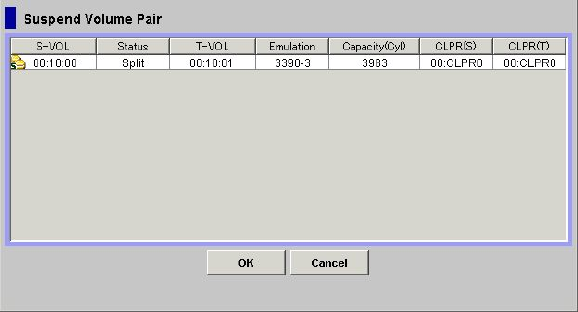HP Hitachi ShadowImage for Mainframe User Guide (T5213-96032, November 2011)
Table Of Contents
- Hitachi ShadowImage™ for Mainframe User's Guide
- Contents
- 1 Overview of Hitachi ShadowImage™ for Mainframe
- 2 About ShadowImage for Mainframe Operations
- 3 Interoperability with other Products and Functions
- Virtual LVI
- Cache Residency Manager
- Volume Security
- Volume Retention Manager
- XP Auto LUN
- HP XP External Storage Software
- Hitachi TrueCopy™ for Mainframe
- XP Continuous Access Journal Software™ for Mainframe
- TrueCopy for Mainframe and Universal Replicator for Mainframe
- HP XP for Compatible Extended Remote Copy (XRC) Software
- Concurrent Copy
- 4 Preparing for ShadowImage for Mainframe Operations
- 5 Using the ShadowImage for Mainframe GUI
- 6 Performing ShadowImage for Mainframe Operations Using Remote Web Console
- Configuring the Volume List
- Changing or Deleting the Settings in Preview List
- Setting or Resetting the Reserve Attribute
- Setting Options
- Configuring CTGs
- Adding Pairs
- Splitting Pairs
- Using PPRC Commands to Split, Resynchronize, and Delete Pairs in a CTG
- Suspending Pairs
- Resynchronizing Pairs
- Deleting Pairs
- Viewing Detailed Volume and Pair Information
- Viewing the Number of Pairs and License Information
- Viewing Pair Operations History
- 7 Performing ShadowImage for Mainframe Pair Operations Using XP for Business Continuity Manager Software
- 8 Performing ShadowImage for Mainframe Pair Operations Using PPRC
- 9 Troubleshooting
- 10 Support and Other Resources
- Glossary
- Index

Suspending Pairs
The Suspend Volume Pair dialog box (see Figure 34 (page 78)) allows you to suspend the pairs.
Figure 34 Suspend Volume Pair Dialog Box
The Suspend Volume Pair dialog box consists of the following components.
• Suspend Volume Pair Volume List
The Volume List located on the upper side of the Suspend Volume Pair panel displays the
following information pertaining to the S-VOL and T-VOL of the pair you want to suspend:
◦ S-VOL: The LDKC:CU:LDEV of the S-VOL.
An LDEV number that ends with a pound or get symbol (#) indicates that the LDEV is an
external volume (for example, 00:00:01#). For details regarding the external volumes,
see the HP XP24000/XP20000 External Storage Software User's Guide.
◦ Status: The pair status displays.
◦ T-VOL: The LDKC:CU:LDEV of the T-VOL.
An LDEV number that ends with a pound or gate symbol (#) indicates that the LDEV is an
external volume (for example, 00:00:01#). For details regarding the external volumes,
see the HP XP24000/XP20000 External Storage Software User's Guide.
◦ Emulation: The emulation type of the S-VOL and T-VOL.
◦ Capacity(Cyl): The number of cylinders assigned to the volume.
◦ CLPR(S): The cache logical partition of the S-VOL.
◦ CLPR(T): The cache logical partition of the T-VOL.
• The OK button adds the operation settings to suspend the selected pairs displayed in the
Suspend Volume Pair Volume List to the Preview List in the Pair Operation window.
You must click Apply in the Pair Operation window to apply the Suspend Volume Pair operation
settings displayed in the Preview List to the storage system.
• The Cancel button cancels the operations set in the Suspend Volume Pair dialog box and closes
the dialog box.
To suspend one or more SIz pairs:
1. Go to the Pair Operation window, and select the desired CU image or S-VOL in the Tree to
filter the volumes displayed in the Volume List.
2. Select the pairs that you want to suspend (or the volumes whose pairs you want to suspend),
right-click the selected pairs to display the menu, and then select the Suspend Pair command
to open the Suspend Volume Pair dialog box.
78 Performing ShadowImage for Mainframe Operations Using Remote Web Console










